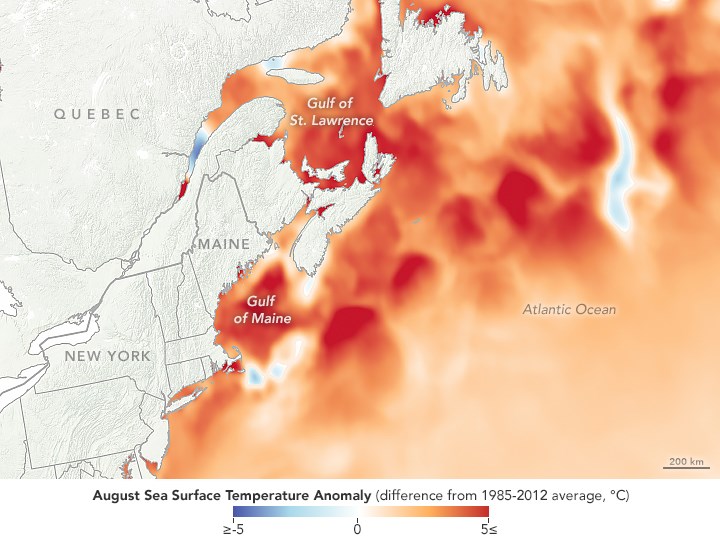Last updated: August 14, 2021
Article
Marine Animals on the Move
"Even if you never have the chance to see or touch the ocean, the ocean touches you with every breath you take, every drop of water you drink, every bite you consume.
Everyone, everywhere is inextricably connected to and utterly dependent upon the existence of the sea."
-Sylvia Earle

NASA Earth Observatory images by Lauren Dauphin, and sea surface temperature data from Coral Reef Watch.
You may be familiar with heat waves on land, but in a changing, warming world, heat waves are starting to become common in the ocean, too. The normally cool Gulf of Maine, which surrounds Acadia National Park, has seen several heat waves in recent years and has spent most of the last two centuries with unusually warm water temperatures. Since 2004, the ocean water temperature has risen approximately 2-3 degrees Fahrenheit. On the surface, this may seem like a small difference, but it has large implications. This increase means the Gulf of Maine is warming 99% faster than the rest of the world’s oceans.
The Gulf of Maine Research Center believes temperatures in the Gulf of Maine are climbing for 2 main reasons:
- Rising air temperatures and greenhouse gas concentrations are causing warming of the oceans worldwide.
- Ice melt in Greenland is pumping fresh water out of the arctic, which is changing normal ocean currents in the region.
These changes are bringing warmer currents into the area and, in turn, are changing what animals we’re seeing inhabit the ocean waters around Acadia National Park. As ocean water temperatures warm, the distribution of many marine species—including those we rely on for food—will shift due to their dependence on specific water temperatures. Warmer water temperatures also deplete vital nutrients and decrease the oxygen content in the water which can also cause species to migrate elsewhere to feed. Once those species shift, the predators that rely on them for food must adapt or follow.

Photo Credit: NOAA
New Species Emerge
Environmental changes have already forced marine creatures, normally found further south, to move into the Gulf of Maine such as:
- Longfin Squid (Doryteuthis (Amerigo) pealeii)
- Black Sea Bass (Centropristis striata)
- Sea Horses (Hippocampus erectus)
- Butterfish (Peprilus triacanthus)
- Ocean Sunfish (Mola mola)
- Green Crab (Carcinus maenas)

Photo Credit: Schoodic Institute
Ironically, the warmer water initially created ideal conditions for lobsters. This contributed to an overabundance in Maine in recent years, causing prices to tumble to their lowest point in nearly two decades. Continued warming may be forcing the lobsters to move even further north toward Nova Scotia. These changes are also harming some of Maine’s other most economically and culturally significant fisheries including shrimp, oysters, scallops, and cod. Other valuable species, such as clams and mussels, are shifting to deeper or more northern waters to stay cool. Clams and mussels are also vulnerable to a new predator: the invasive green crabs that are thriving in Maine’s warming waters.

Photo credit: USFWS

Photo Credit: NOAA
This is not only an Acadia National Park issue. Over 80 National Park sites are coastal, so it's likely you have been to other sites that will be facing these same issues due to climate change. If left to current devices, these changes will continue to affect our treasured ocean ecosystems and every branch of the food web. Learn more about the changes that Acadia and other national parks are going through and what you can do to help.
